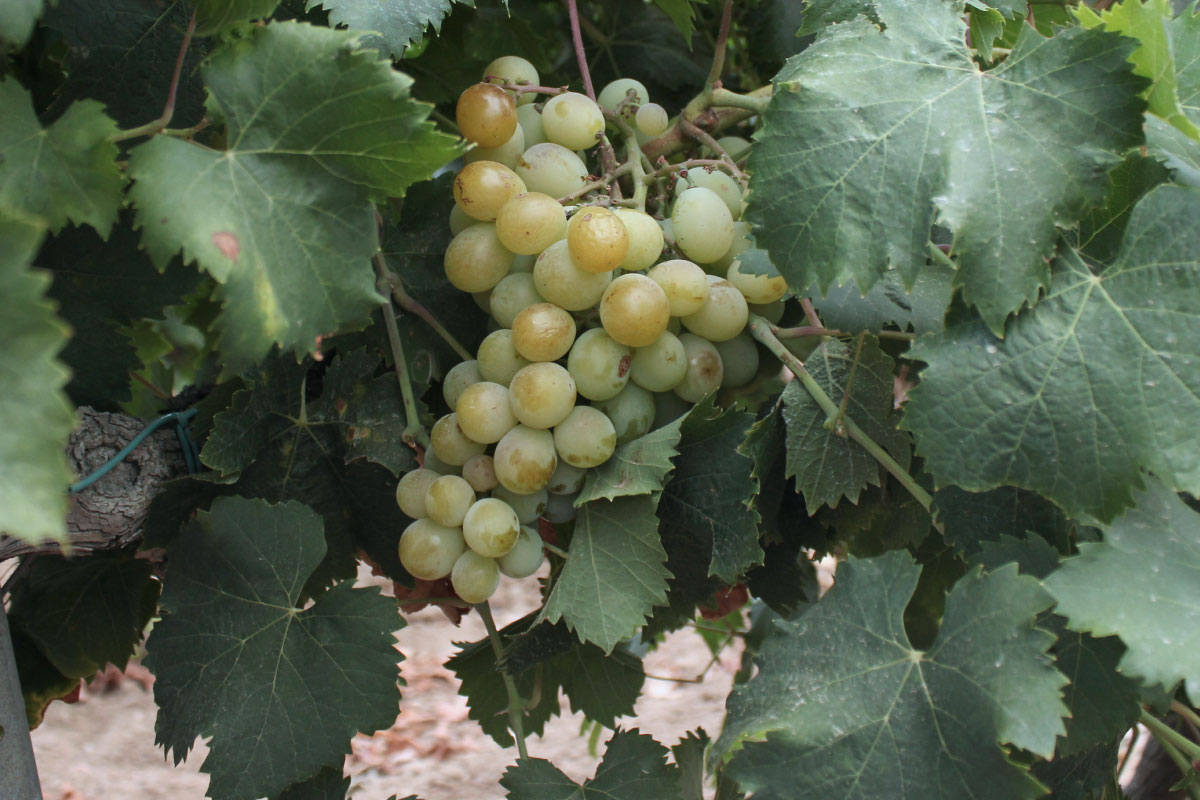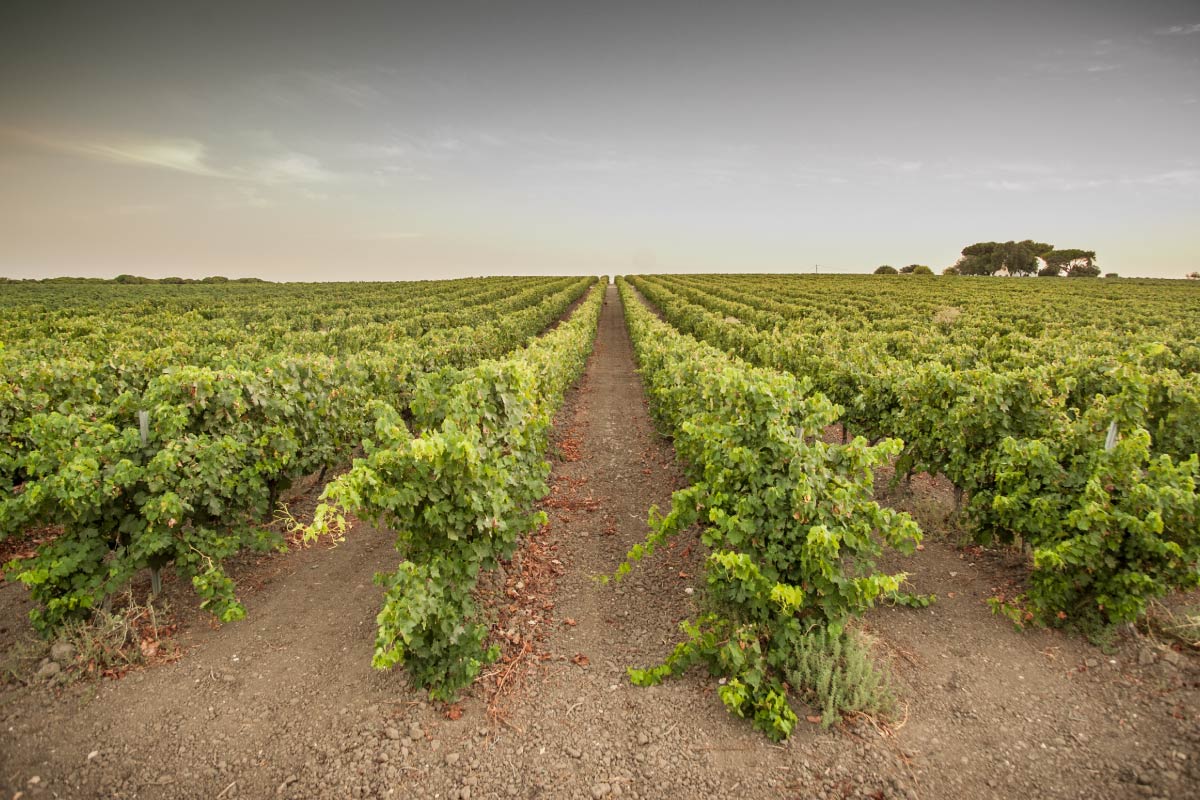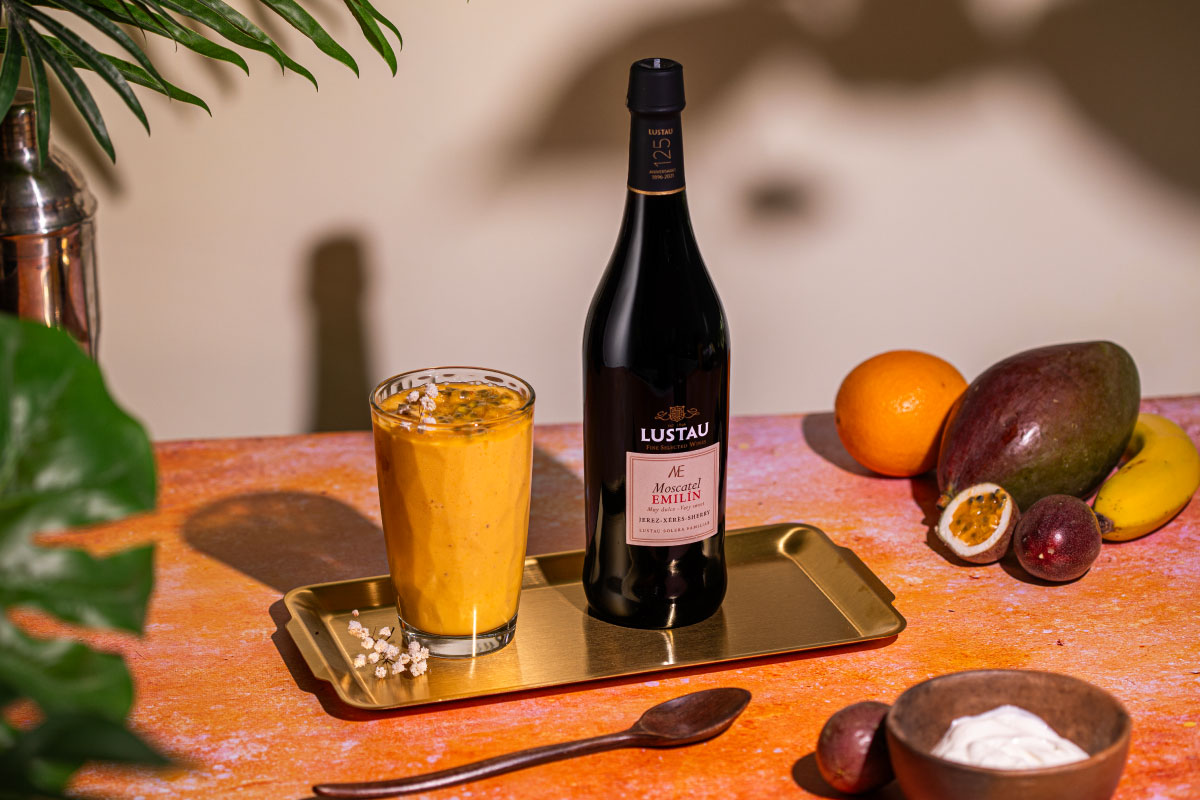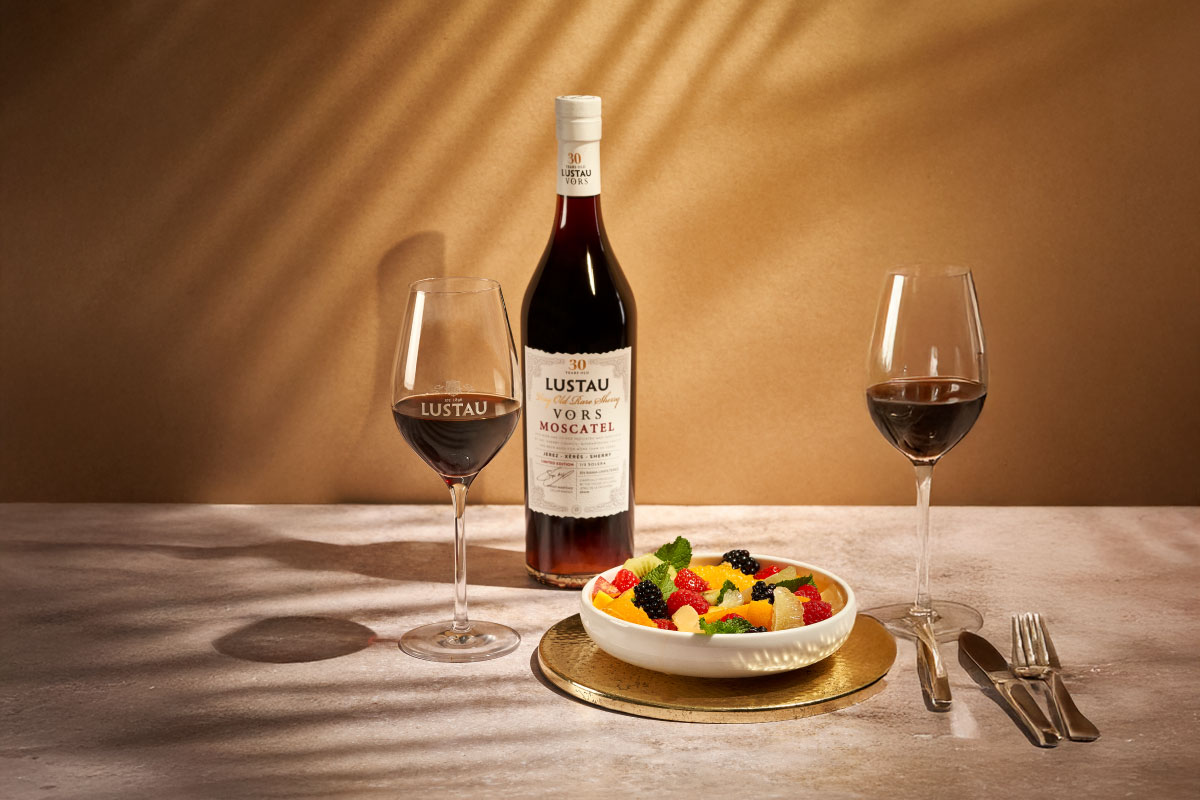Moscatel is one of the most singular and aromatic expressions within the sherry spectrum, yet often one of the least understood and with the least exposure. While names like manzanilla, fino, amontillado, palo cortado or oloroso are familiar even outside Spain, moscatel remains a quiet style, deeply tied to its grape variety, geography, and centuries of winemaking tradition. To understand “what is moscatel” is to explore a style that is at once floral and exuberant, sweet but always lively, and capable of revealing as much cultural heritage as enological know-how.
This article examines the origins of moscatel, the technical details of how sherry moscatel is crafted, the sensory profile that distinguishes it, and the ways it can be appreciated both at the table and in the cocktail glass.

THE ORIGIN AND HISTORY OF MOSCATEL
The very origin of moscatel begins with the grape itself: moscatel de Alejandría, a member of the large muscat family that has been cultivated since ancient times in the region. Greeks and Romans praised muscat wines for their perfume, while Arab agronomists helped spread its cultivation during centuries of Mediterranean expansion.
Moscatel has always had cultural resonance. In Andalusia, it appears at festive tables, alongside pastries flavored with honey and citrus. In Málaga and Valencia, similar wines were poured at religious holidays, becoming part of local identity. Within the Jerez region, moscatel developed its own path, distinct from any dry or sweet wine, yet equally bound to tradition. Its combination of perfume, sweetness, and versatility has guaranteed it a place in the region.
THE WINEMAKING PROCESS BEHIND MOSCATEL
GRAPE VARIETY: MUSCAT OF ALEXANDRIA AND ITS EXPRESSION
In Spain, moscatel has found an especially suitable home along the southern Atlantic coast. Here, vineyards planted on sandy soils — known locally as arenas — near Chipiona, Chiclana, and Rota, benefit from constant maritime breezes and intense sunlight. This environment allows grapes to achieve high levels of ripeness without losing the acidity necessary to keep wines fresh and balanced. Over time, these vineyards became the cradle of moscatel destined for wine production.
This variety is used for the production of wines with the same name, moscatel. In the area it is common to call this variety “moscatel de Chipiona” since it is in the sandy soils of this location where most of its vineyards are concentrated. Its proximity to the sea favors its development.
Moscatel de Chipiona is instantly recognizable in the vineyard. The bunches are large, the berries golden-green and thick-skinned, filled with aromatic compounds responsible for hallmark notes of orange blossom, jasmine, honeysuckle, and rose petal. Ripe fruit brings flavors of apricot, peach, and candied citrus.
Lustau is the largest producer of moscatel in the region and produces sweet wines from this variety through late, non-sundried, harvests. The moscatel plantings are located in the Las Cruces vineyard in the municipality of Chipiona.
HARVESTING AND TRADITIONAL SUN-DRYING (ASOLEO)
The harvest of moscatel grapes intended for sherry moscatel typically takes place later than that of palomino, allowing the fruit to reach optimal ripeness and accumulate high sugar levels naturally.
In certain vineyard sites, such as Lustau’s, the grapes are left on the vine longer to further concentrate sugars — a method known as late harvest. This practice, not very common, enhances aromatic intensity and provides a lush, honeyed base even before any post-harvest treatment. However, the grapes can also undergo asoleo, the time-honored process of sun-drying. After picking, bunches are laid out on straw mats in open-air patios for several days under the strong Andalusian sun. Water evaporates gradually, and the berries become partially raisined, concentrating sugars, acids, and aromas. The grapes are turned regularly to ensure even dehydration and protected from excessive humidity or rainfall, which could spoil their condition.
The outcome is fruit of extraordinary richness — dense, fragrant, and golden — yet still retaining the floral imprint of the moscatel variety. Whether obtained through late harvesting, or “asoleo”, this natural concentration defines moscatel’s hallmark style: sweet, perfumed, and balanced by the freshness that coastal vineyards provide.

FERMENTATION CONTROL AND NATURAL SWEETNESS
Once the grapes have reached the desired concentration through late harvest and/or “asoleo”, they are gently pressed to obtain an intense, aromatic must. Fermentation is initiated under strict temperature control to preserve the variety’s delicate aromas.
FORTIFICATION AND THE ROLE OF ALCOHOL IN MOSCATEL
Crucially, sweetness in moscatel is not the result of a natural stop: cellar masters deliberately arrest fermentation by fortification. After only a brief fermentation, when a few degrees of alcohol have formed and the aromatic profile is at its most vivid, a neutral grape spirit is added to raise the wine to roughly 15–17% ABV, instantly halting yeast activity and locking in a substantial proportion of the grape’s natural sugars. This precise timing determines the final balance between alcohol, natural sweetness, acidity, and it safeguards the primary floral character that defines this moscatel de Chipiona variety.
AGING METHODS: FROM YOUNG AROMATIC TO VOS AND VORS
Moscatel can take different paths after fortification. Some wines are bottled relatively young to showcase exuberant floral and fruity aromas. These expressions are golden in color, intensely perfumed, and immediately accessible. Others enter the traditional solera and criaderas system, where oxidative aging transforms the wine. Younger wines are progressively blended with older ones, ensuring consistency and complexity unparalleled to the rest of the wine world. This stage can extend for several years, with the length of aging significantly influencing the wine’s depth and personality.
Learn more about the solera and criaderas system here
With time, moscatel develops deeper colors — amber to mahogany — and flavors of coffee, cocoa, toffee, dried figs, and candied orange peel. Textures become more unctuous, and complexity multiplies. The most exceptional examples achieve classifications of VOS (Very Old Sherry, minimum average age 20 years) or VORS (Very Old Rare Sherry, minimum average age 30 years). These wines embody the pinnacle of Moscatel craftsmanship.
BLENDING AND BOTTLING: FINALIZING THE STYLE
Before bottling, cellar masters blend wines from different barrels to achieve a consistent profile. This ensures that each release reflects both the house style and the distinct character of Moscatel. The bottled wine may highlight youthful perfume, aged depth, or a combination of both, depending on the producer’s vision.
KEY CHARACTERISTICS AND FLAVOR PROFILE OF MOSCATEL
TYPICAL AROMAS, TASTING NOTES, AND TEXTURE
Moscatel is defined by its distinct aroma: orange blossom, jasmine, honeysuckle, and rose, followed by candied citrus, stone fruits, fig, and raisin. Old moscatel deepens into amber and mahogany hues, gaining flavors of roasted coffee, cocoa, toffee, caramelized nuts, mint and spice.
On the palate, this wine is sweet but not cloying. High acidity and subtle bitterness from coastal vineyards balance richness. Textures range from silky in young bottlings to velvety in older wines.
HOW MOSCATEL DIFFERS FROM PEDRO XIMÉNEZ AND CREAM SHERRIES
When it comes to comparing moscatel with other sweet sherry styles, moscatel is the most vivid and floral of all. Unlike pedro ximénez, which is typically richer and more robust, moscatel retains the crisp, floral notes of the fresh moscatel variety while introducing layers of oxidative complexity. Cream, on the other hand, is crafted through a meticulous coupage of oloroso and pedro ximénez, ending with a different personality.
Pedro Ximénez: It is common to compare moscatel with pedro ximénez due to their similar elaboration, but the differences are significant. PX, always made from sun-dried pedro ximénez grapes, is denser, darker, and almost syrup-like, with flavors of dates, molasses, and licorice. Its residual sugar content can double moscatel making px the sweetes style of the entire sherry spectrum.

Cream: It is not monovarietal like moscatel or px despite of its sweetness. This blended style, often based on oloroso and sweetened with px, is known for gathering the best from the dry, oxidative identity of the oloroso and the velvety, fruity character of the pedro ximénez. As a result, cream styles are savory, sweet, with high acidity levels that help the wine linger for a long time.

LUSTAU MOSCATEL COLLECTION
Lustau is known for its diverse and versatile range of styles organized in different collections designed under various concepts and profiles; all suited for any palate and moment.
Lustau Moscatel collection explores a few different expressions of this genuine wine. Despite all expressions being defined by Lustau’s approachable style each bottling provides different insights into the craftsmanship behind late harvested moscateland its evolving character over time.
Lustau Moscatel Emilin

Lustau Moscatel VORS

FOOD PAIRINGS AND SERVING SUGGESTIONS FOR MOSCATEL
Moscatel’s expressiveness extends beyond the dining table or the cocktail glass, making it a perfect wine for a variety of occasions and moods. Its sweetness and perfume make it versatile with desserts, but its acidity allows it to stand beside savory dishes as well. Ideal for intimate moments, relaxing, even as a pairing with music—think smooth R&B, Blues or NYC style jazz—it invites you to explore its genuineness in any context.
Whether savoring it with food, enjoying it as part of a self-crafted cocktail, or sipping it during a quiet evening of watching your favorite show, moscatel transforms every moment into an experience of refined indulgence.
When serving moscatel, chill lightly — too cold aromas get muted, too warm sweetness can feel heavy. The ideal range is (10-12ºC – 50-54ºF). Remember always to pour in white wine glasses.
And for those looking to explore creative and unexpected pairings, discover how Lustau Moscatel Emilin creates a twist in sensations with everyday dishes (or some other more suited to a self-treat) with these inspiring combinations. Click on the visuals to discover more about the
pairing ideas!
BEST COCKTAILS USING MOSCATEL
In recent years, bartenders have rediscovered moscatel as a valuable ingredient for cocktails. Its combination of natural sweetness, aromatics, and moderate alcohol makes it versatile. It works as a classy sweetener, combining perfectly with gin and pisco, enhacing the fruitiness and freshness of both spirits.
The Moscatel Spritz is a great example of how a sweet wine can be the epicenter of a cocktail personality, offering a refreshing twist (Lustau moscatel, champagne, and fresh lime juice with citrus peel).
FREQUENTLY ASKED QUESTIONS ABOUT MOSCATEL
Its Role in Spanish Dessert Traditions and Festivities
Moscatel belongs to Spanish celebrations. During Christmas, Easter, and local festivals, it accompanies pastries flavored with honey, citrus, and almonds. Its floral lift keeps the pairing lively even with rich or sweet foods. In Andalusian households, moscatel has long been both a celebratory drink and a familiar presence on the table.
Why Bartenders and Sommeliers Are Rediscovering Moscatel
For sommeliers, moscatel represents an opportunity to present guests with a distinctive sherry style that balances history with modern appeal. It pairs naturally with desserts and cheeses, but it also educates palates on the diversity of sherry beyond the classic sweet styles.
For bartenders, moscatel can become a versatile ingredient that bridges European wine and spirit traditions. Its sweetness eliminates the need for syrups, while its aromatics elevate classic cocktails. Together, these factors explain why moscatel is increasingly more visible in cocktail and mixology programs.







